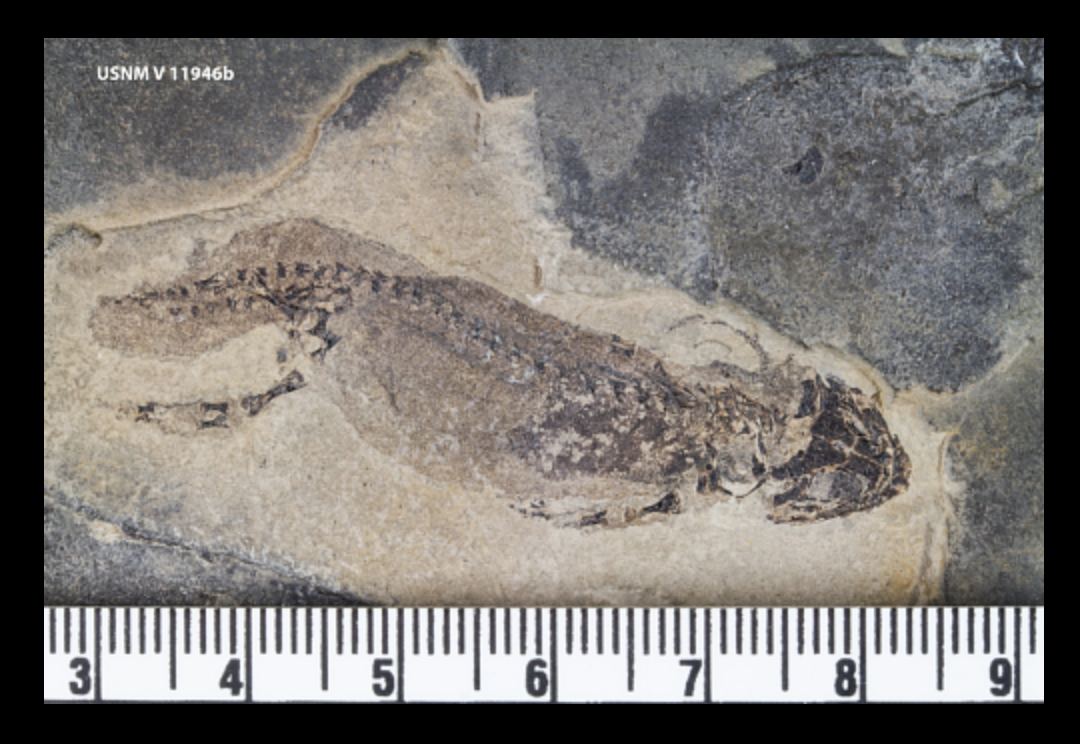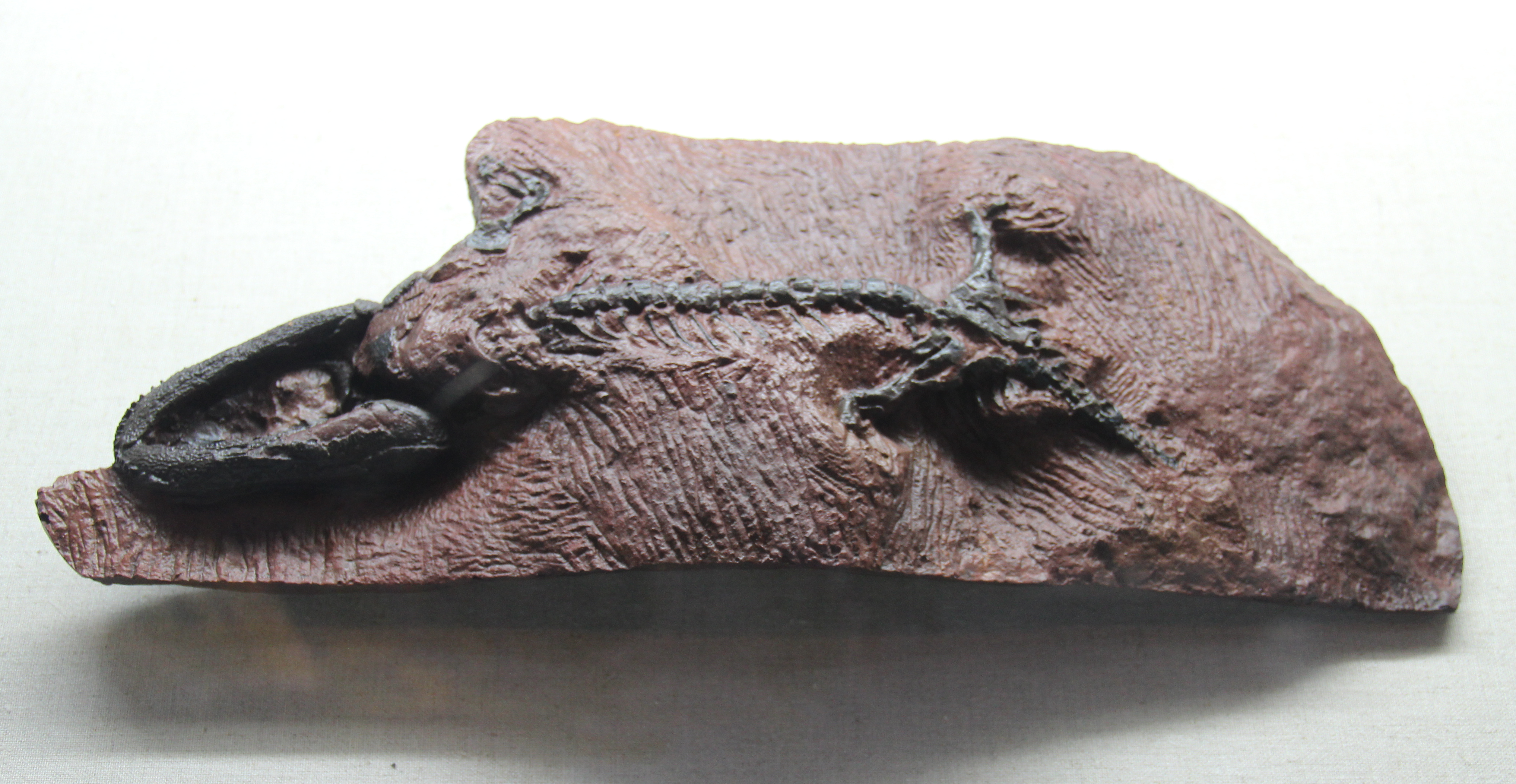|
Perryella
''Perryella'' is an extinct genus of dvinosaurian(?) temnospondyl from the Permian of Oklahoma. History of study The type and only species, ''P. olsoni'', was named in 1987 from the Wellington Formation exposures of Noble County, Oklahoma, which is Early Permian in age. It is known from several skulls and partial remains of vertebrae and limbs. The genus name is for the nearby town of Perry, Oklahoma. The specific name honors the American paleontologist Everett C. Olson. A subsequent study by Ruta & Bolt (2006) was based on the further preparation of the cranial material in particular. Anatomy ''Perryella'' has a melange of different features, which contributes to uncertainty regarding its phylogenetic position (see below). It has proportionately large orbits and interpterygoid vacuities and a well-developed otic notch. Ruta & Bolt (2006) listed an extensive number of features that contribute to a unique combination of features, such as a frontal entering the orbit; orb ... [...More Info...] [...Related Items...] OR: [Wikipedia] [Google] [Baidu] |
Dvinosauria
Dvinosaurs are one of several new clades of Temnospondyl amphibians named in the phylogenetic review of the group by Yates and Warren 2000. They represent a group of primitive semi-aquatic to completely aquatic amphibians, and are known from the Late Carboniferous to the Early Triassic, being most common in the Permian period. Their distinguishing characteristics are a reduction of the otic notch; the loss of a flange on the rear side of the pterygoid; and 28 or more presacral vertebrae. Trimerorhachidae is the most basal family of dvinosaurs. Most other dvinosaurs are placed in the superfamily Dvinosauroidea. Within Dvinosauroidea are two families, Eobrachyopidae and Tupilakosauridae, as well as dvinosaurs that cannot be placed in either family, such as ''Dvinosaurus'' and '' Kourerpeton''. A 2008 phylogenetic analysis found Eobrachyopidae to be paraphyletic, representing a grade of basal dvinosauroids. Below is a cladogram showing the phylogenetic relationships of dv ... [...More Info...] [...Related Items...] OR: [Wikipedia] [Google] [Baidu] |
1987 In Paleontology
Plants Angiosperms Molluscs Newly described bivalves Arthropods Newly described arachnids Newly described crustaceans Newly described insects Vertebrates * Stokes suggested that sauropods recycled their gastroliths and chose them based on brightness of color.Sanders, F.; Manley, K.; & Carpenter, K. 2001. Gastroliths from the Lower Cretaceous sauropod *Cedarosaurus weiskopfae*. pp. 166-180. In: Newly described dinosaurs Newly named birds Pterosaurs New taxa References {{reflist, 30em Paleontology Paleontology (), also spelled palaeontology or palæontology, is the scientific study of life that existed prior to, and sometimes including, the start of the Holocene epoch (roughly 11,700 years before present). It includes the study of fos ... Paleontology 7 ... [...More Info...] [...Related Items...] OR: [Wikipedia] [Google] [Baidu] |
Capetus
Capetus or Capetus Silvius (said to have reigned 934-921 BC)Dionysius of Halicarnassus Dionysius of Halicarnassus ( grc, Διονύσιος Ἀλεξάνδρου Ἁλικαρνασσεύς, ; – after 7 BC) was a Greek historian and teacher of rhetoric, who flourished during the reign of Emperor Augustus. His literary sty ... ''Roman Antiquities'' 1.71() was a descendant of Aeneas and one of the legendary Latin kings of Alba Longa. He was the son of Capys, and the father of Tiberinus, after whom the Tiber river was named. Family tree Bibliography Geoffrey of Monmouth '' History of the Kings of Britain'' In parentheses Publications Medieval Latin Series Cambridge, ''Ontario'' 1999 page 27. References {{AncientRome-myth-stub Kings of Alba Longa ... [...More Info...] [...Related Items...] OR: [Wikipedia] [Google] [Baidu] |
Balanerpeton
''Balanerpeton'' is an extinct genus of temnospondyl amphibian from the Visean stage of the Early Carboniferous period. It is estimated to reach up to in length. ''Balanerpeton woodi'' was discovered by Stanley Wood and is the earliest and most common tetrapod in the East Kirkton Limestone of the East Kirkton Quarry assemblage of terrestrial amphibians in Scotland. Characteristics of ''Balanerpeton woodi'' include the presence of large external nares, large interpterygoid vacuities (holes in the back of the palate), and an ear with a tympanic membrane and rod-like stapes. Numerous studies and research regarding ontogeny in non extant taxa have been oriented around this taxon. The morphology of the stapes suggests that the animal was capable of hearing high-frequency sound. ''B. woodi'' does not possess lateral line sulci or an ossified Ossification (also called osteogenesis or bone mineralization) in bone remodeling is the process of laying down new bone material by cell ... [...More Info...] [...Related Items...] OR: [Wikipedia] [Google] [Baidu] |
Branchiosauridae
Branchiosauridae is an extinct family of small amphibamiform temnospondyls with external gills and an overall juvenile appearance. The family has been characterized by hundreds of well-preserved specimens from the Permo-Carboniferous of Middle Europe.Schoch, R.R. 2008. The intrarelationships and evolutionary history of the temnospondyl family branchiosauridae. Journal of Systematic Palaeontology. 6(4):409-431. Specimens represent well defined ontogenetic stages and thus the taxon has been described to display paedomorphy (perennibranchiate). However, more recent work has revealed branchiosaurid taxa that display metamorphosing trajectories.Schoch, R.R. and Frobisch, N.B. 2006. Alternative Pathways in an Extinct Amphibian Clade. Evolution. 60(7):1467-1475 The name Branchiosauridae (“Branchio” in Ancient Greek denoting gills and “saurus” meaning lizard) refers to the retention of gills. Geological/paleoenvironmental information Branchiosaurids mostly inhabited Permo-Car ... [...More Info...] [...Related Items...] OR: [Wikipedia] [Google] [Baidu] |
Micromelerpeton
''Micromelerpeton'' is an extinct genus of dissorophoidean euskelian temnospondyl within the family Family (from la, familia) is a group of people related either by consanguinity (by recognized birth) or affinity (by marriage or other relationship). The purpose of the family is to maintain the well-being of its members and of society. Idea ... Micromelerpetontidae. References Further reading * Dissorophoids Fossils of Germany Prehistoric amphibian genera Carboniferous temnospondyls of Europe Permian temnospondyls of Europe Fossil taxa described in 1926 {{Temnospondyli-stub ... [...More Info...] [...Related Items...] OR: [Wikipedia] [Google] [Baidu] |
Doleserpeton
''Doleserpeton'' is an extinct, monospecific genus of dissorophoidean temnospondyl within the family Amphibamidae that lived during the Upper Permian, 285 million years ago. ''Doleserpeton'' is represented by a single species, ''Doleserpeton annectens'', which was first described by John R. Bolt in 1969.Sigurdsen, Trond, and John R. Bolt. "The Lower Permian Amphibamid Doleserpeton (temnospondyli: Dissorophoidea), the Interrelationships of Amphibamids, and the Origin of Modern Amphibians." Journal of Vertebrate Paleontology. 30.5 (2010): 1360-1377. Print. Fossil evidence of ''Doleserpeton'' was recovered from the Dolese Brothers Limestone Quarry in Fort Sill, Oklahoma. The genus name ''Doleserpeton'' is derived from the initial discovery site in Dolese quarry of Oklahoma and the Greek root "herp-", meaning "low or close to the ground". This transitional fossil displays primitive traits of amphibians that allowed for successful adaptation from aquatic to terrestrial environments. In ... [...More Info...] [...Related Items...] OR: [Wikipedia] [Google] [Baidu] |
Amphibamus
''Amphibamus'' is a genus of amphibamid temnospondyl amphibians from the Carboniferous (middle Pennsylvanian Pennsylvanian may refer to: * A person or thing from Pennsylvania * Pennsylvanian (geology) The Pennsylvanian ( , also known as Upper Carboniferous or Late Carboniferous) is, in the International Commission on Stratigraphy, ICS geologic timesca ...) of North America. This animal is considered to have been close to the ancestry of modern amphibians. Its length was about 20 cm. Gallery Image:Amphibamus.jpg, ''Amphibamus grandiceps'' skeleton References Amphibamids Dissorophids Carboniferous temnospondyls of North America Taxa named by Edward Drinker Cope Fossil taxa described in 1865 Prehistoric amphibian genera {{Temnospondyli-stub ... [...More Info...] [...Related Items...] OR: [Wikipedia] [Google] [Baidu] |
Eoscopus
''Eoscopus'' is an extinct genus of dissorophoidean euskelian temnospondyl in the family Micropholidae. It is known from Hamilton Quarry, a Late Carboniferous lagerstätte near Hamilton, Kansas. Members of Micropholidae were historically included in Amphibamidae, but Schoch (2019) recovered Amphibamidae as paraphyletic, necessitating resurrection of Micropholidae for ''Micropholis'' and closely related taxa. See also * Prehistoric amphibian * List of prehistoric amphibians This list of prehistoric amphibians is an attempt to create a comprehensive listing of all genera from the fossil record that have ever been considered to be amphibians, excluding purely vernacular terms. The list includes all commonly accepted g ... References Amphibamids Dissorophids Prehistoric amphibian genera Carboniferous amphibians of North America Fossil taxa described in 1994 {{temnospondyli-stub ... [...More Info...] [...Related Items...] OR: [Wikipedia] [Google] [Baidu] |
Platyrhinops
''Platyrhinops'' is an extinct genus amphibamid temnospondyl from the Late Carboniferous (late Westphalian stage) of Ohio and the Czech Republic. It is known from many partial skeletons from the Linton site in Saline Township, Ohio and at least 6 partial specimens from the Nýřany site from the Nýřany Member of the Kladno Formation in the Czech Republic. Gallery Image:Amphibamus.JPG, Cast of holotype at UALVP. Image:Platyrhinops lyelli.jpg, Cast of holotype in the Field Museum of Natural History See also * Prehistoric amphibian * List of prehistoric amphibians This list of prehistoric amphibians is an attempt to create a comprehensive listing of all genera from the fossil record that have ever been considered to be amphibians, excluding purely vernacular terms. The list includes all commonly accepted g ... References Amphibamids Dissorophids Fossil taxa described in 1931 Pennsylvanian temnospondyls of Europe Pennsylvanian temnospondyls of North America C ... [...More Info...] [...Related Items...] OR: [Wikipedia] [Google] [Baidu] |
Olsoniformes
Olsoniformes is a clade of dissorophoid temnospondyls. It includes the families Dissorophidae and Trematopidae. Most members of the clade were highly adapted to a terrestrial lifestyle. The clade was named in 2008 and is defined as the least inclusive clade containing ''Dissorophus multicinctus'' (a dissorophid) and ''Acheloma cumminsi'' (a trematopid) but not ''Amphibamus grandiceps, Micromelerpeton credneri,'' and ''Apateon pedestris''. Olsoniforms share various features such as a stout and low ilium and a thin cultriform process. Trematopids are known from the Late Carboniferous and the Early Permian of Europe and across much of North America, while dissorophids are primarily found in Early Permian deposits in the central United States The United States of America (U.S.A. or USA), commonly known as the United States (U.S. or US) or America, is a country primarily located in North America. It consists of 50 U.S. state, states, a Washington, D.C., federal district, ... [...More Info...] [...Related Items...] OR: [Wikipedia] [Google] [Baidu] |
Dendrerpeton
''Dendrerpeton'' (from el, δένδρον , 'tree' and el, ἑρπετόν , 'creeping thing') is a genus of an extinct group of temnospondyl amphibians. Its fossils have been found primarily in the Joggins Formation of Eastern Canada and in Ireland. It lived during the Carboniferous and is said to be around 309–316 million years of age, corresponding to more specifically the Westphalian (stage) age. Of terrestrial temnospondyl amphibians evolution, it represents the first stage. Although multiple species have been proposed, the species unanimously recognized is ''D. acadianum''. This species name comes from “Acadia” which is a historical name for the Nova Scotia region as a French colony. It refers to the location of the coal field at which the fossil was found. History and discovery The majority of ''Dendrerpeton'' fossils that had been discovered were disarticulated due to the way in which they had formed. They are often associated with Lycopod, Sigillaria, and Cal ... [...More Info...] [...Related Items...] OR: [Wikipedia] [Google] [Baidu] |



